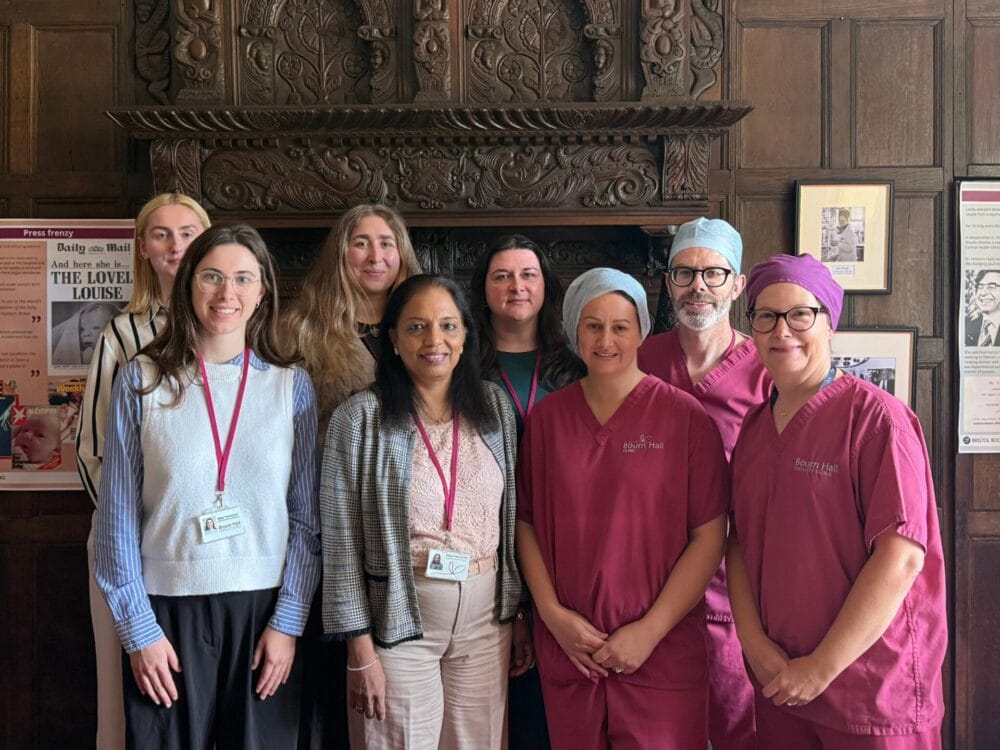IVF vs IUI: Which Fertility Treatment Is Best for You?
10 Oct 2025
By Dr Thanos Papathanasiou, CEO & Medical Director, Bourn Hall Fertility Clinic, UK
One of the first questions many people ask is whether to try intrauterine insemination (IUI) or go straight to in vitro fertilisation (IVF). This is not just a medical choice. It is about values, priorities, and how long someone feels able to keep trying. Both treatments can lead to a baby, but the paths are different.
Since the first IVF baby was born in 1978, more than 12 million babies worldwide have been born through IVF. What began as an experimental procedure is now one of the most widely used medical treatments in the world.
When IVF Is the Only Option
In some cases, there is no real decision to make. If sperm counts are very low, IVF with ICSI is the only realistic way forward. Similarly, if the fallopian tubes are blocked, sperm and egg cannot meet naturally, so IUI cannot be offered.
When Both IVF and IUI Are Possible
More often, both treatments are technically feasible. This is typically the case in unexplained infertility or when sperm counts are normal. Then the choice depends on what matters most to you.
Recent HFEA data from 2023 underline how IVF is increasingly used in the UK: over 77,500 IVF cycles were carried out by around 52,400 patients, resulting in approximately 20,700 babies born via IVF. IVF births now account for about 3.1% of all UK births – roughly one in every 32 babies. For women aged 40-44, 11% of live births were a result of IVF in 2023.
By contrast, donor insemination (DI, which is a form of IUI when donor sperm is used) resulted in about 5,500 cycles and 820 babies born in the same year. Partner-sperm IUI data are less prominently reported, but the overall scale is much smaller than IVF.
IUI and the Idea of Natural Conception
One reason people lean toward IUI is that it feels “closer to natural.” Fertilisation happens inside the body rather than in a laboratory. For many, this feels less medical and therefore more comfortable.
It is important, though, to be realistic about what IUI involves. Medical IUIs are not the same as home inseminations. They often include hormone medication to stimulate the ovaries, several ultrasound scans, sperm preparation, and then the insemination itself performed by a clinician. In that sense, IUI is not truly “natural,” though it may still feel more aligned with nature than IVF. For younger women with good ovarian reserve, IUI can be a perfectly valid first step – particularly if they value a lighter-touch treatment.
IVF vs IUI Success Rates: Why They Differ
At Bourn Hall, IVF tends to be significantly more successful than IUI.
- IVF gives multiple chances from one cycle. Several eggs are usually collected, and some develop into embryos. The best embryos are chosen for transfer, and extra embryos can be frozen for later use. By contrast, IUI relies on the single egg released that month.
- IVF allows embryo selection. Embryologists can prioritise embryos with the highest developmental potential, something that IUI cannot offer.
For women under 35, around 60% of Bourn Hall patients will have a baby from a single egg retrieval, compared with no more than about 15% per IUI attempt. The comparison is not exact – IVF success is often quoted per retrieval, not per transfer – but the pattern is clear across ages: IVF is more powerful.
It is also important to consider time. Fertility treatment can take months or even years. While treatment is ongoing, egg quality continues to decline. This means that delays – whether through repeated IUIs or breaks between treatments – can reduce the overall chances of success.
Emotional Impact: Fewer Failures, Less Trauma
Every negative pregnancy test is emotionally draining. IVF, by being more powerful, can reduce the number of failed cycles needed before success. That does not mean IVF is easy – it requires injections, procedures, and a heavier upfront burden. But many patients find that fewer failed attempts overall means less cumulative stress and less time lost.
Safety and Risks
The main risk to baby health is multiple pregnancy. Twins and triplets carry higher risks of prematurity and complications. IVF allows tight control by transferring a single embryo. The small chance of an embryo splitting (about 1-2%) exists regardless of treatment.
With IUI, the picture is mixed.
- A natural cycle IUI, without fertility drugs, has a very low risk of multiples but also low success.
- A stimulated IUI, using mild hormone medication, improves the chance of success but increases the risk of twins or triplets. Clinics usually cancel cycles if too many eggs develop, but the control is not as precise as with IVF.
It is also fair to say that IVF itself has risks – ovarian hyperstimulation, egg collection procedures, and the stress of more intense treatment. Neither pathway is risk-free; the differences are in the type of risks.
Cost of IVF vs IUI
One cycle of IUI costs less than one cycle of IVF. That is why IUI often feels like the “gentler” starting point.
But if the endpoint is to have a baby, not just to “try once,” the equation changes. Several IUIs followed by IVF can add up to the same or more than starting IVF directly.
At Bourn Hall, we have designed multi-cycle IVF packages to reduce the burden of treatment. These packages spread the cost across several cycles and include unlimited frozen embryo transfers, so patients who create multiple embryos can use them without extra charges. This makes it easier to commit to single embryo transfer, avoiding the risks of multiple pregnancy without feeling pressured to “use everything at once.” The package is available to anyone who wishes to plan their treatment in this way, without needing medical approval. It is part of our effort to create options that add value and reduce the stress of treatment, not just financially but emotionally too.
IVF and Family-Building Potential
IVF offers some advantages beyond the immediate cycle. Many patients create more embryos than they need at first, and these can be frozen. That gives them the option of another baby later without starting a full new cycle.
IVF can also be used proactively: storing embryos at a younger age, when egg quality is better, for future family building.
PGT-A: An Option Some Patients Value
Another topic that often comes up is PGT-A (preimplantation genetic testing for aneuploidy). It involves testing embryos for chromosomal differences before transfer.
- What PGT-A can do: It helps identify embryos that are very unlikely to develop into a baby, which can reduce the number of unsuccessful transfers. For some patients, this means fewer negative tests, less waiting, and less emotional burden. Many also value the sense of control it provides.
- What it does not do: PGT-A does not increase the overall chance of a baby. This is why the National Institute for Health and Care Excellence (NICE) does not currently recommend it for routine use.
- When it may be considered: PGT-A may be more relevant for patients with repeated unsuccessful transfers or recurrent miscarriage, or those who want to minimise the number of attempts (especially when they have created supernumerary embryos). It is an option, not a requirement, and should be weighed carefully in discussion with your clinician.
Age and National Guidance
NICE’s latest draft guidance recommends IVF for heterosexual couples who have tried with regular intercourse and meet the criteria. For single women and same-sex female couples using donor sperm, NICE recommends starting with IUI.
It is worth noting that NICE does not specify an age limit for donor IUI. From our experience at Bourn Hall, however, once a woman is 38 years or older, the chance of success with IUI – donor or partner – becomes quite low. Because of this, we generally advise against IUI beyond that age if success, speed, and avoiding repeated failure are the priority. Exceptions exist, but in most cases IVF provides the more effective option.
IUI and IVF with Donor Sperm
For single women and same-sex female couples, the same principles apply. Being otherwise healthy at 40 does not reverse the effect of age on eggs, so IUI is less likely to succeed. Some still choose to begin with IUI for its simplicity or because it aligns with NICE’s recommendation. Others, especially those who want to move faster, may prefer IVF. IVF also allows reciprocal IVF (also called: shared motherhood), where both partners in a female couple share in the process.
Making the Right Choice
There is no single “best” treatment. Both IUI and IVF are valid. The key is to align the medical facts with what matters most to you: staying closer to natural conception, maximising success, limiting risks, minimising costs, or building for the future.
What matters above all is not losing time, not accumulating trauma through repeated failures, and not delaying unnecessarily. That balance – between evidence and personal priorities – is the essence of good fertility care.

Find out how can we help you
Book a consultation call with our team to find out how Bourn Hall can help you on your fertility journey
Latest articles
Understanding Success Rates
Fertility statistics can sometimes feel confusing or even discouraging. Percentages and figures don’t always tell…
Let’s Make IVF More Accessible for All
By Dr Thanos Papathanasiou, CEO & Medical Director, Bourn Hall The pioneers of IVF and…
Donor and surrogacy services – Bourn Hall Clinic
Our donation and surrogacy service is led by Dr Chhaya Prasannan-Nair, a highly experienced gynaecologist…
Patient reviews you can trust
Genuine experiences from real patients. See why so many trust us with their fertility care.
“We went to an open evening at Bourn Hall Wickford and came away feeling really positive about the place. The staff were really friendly and the presentation was clear about the statistics regarding success rates and live birth rates; their data was very transparent. We came away feeling like we would really be looked after.”
Katy and Leigh are parents to Charlie after IVF
Patient 2023
“We chose to make an appointment at Bourn Hall Wickford because of the favourable reviews. When we got there and met the staff they were just so lovely, making us feel welcome and explaining to us what tests would need to be done and what our options were; we just thought ‘yes, let’s get the ball rolling!”
Jess and Fran are mums to Nathan after IVF with donor sperm
Patient 2023




